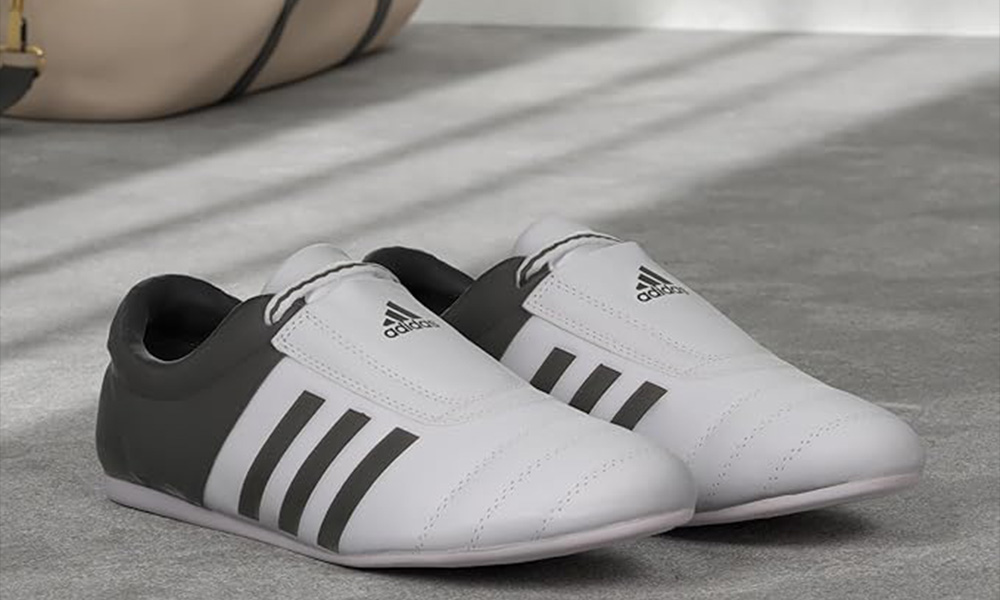
If you’ve followed streetwear trends, you’ve likely noticed the buzz around Adidas Taekwondo sneakers. Fashion editors call them the next must-have, replacing the Samba as the slim sneaker of choice. They point to the sleek leather design and martial arts roots as reasons these shoes appear on runways and in casual outfits.
Others note how the shoes combine early 2000s vibes with modern versatility, perfect for pairing with jeans or dresses. The Adidas Taekwondo trend builds on this momentum, with people spotting them on celebrities and in stores as a fresh alternative to bulkier options.
These sneakers draw from Taekwondo’s clean lines, but that’s where the link ends. The Adidas Taekwondo sneaker serves as streetwear, not as training or competition footwear; here’s what to wear for class and what rules permit at events.
If you’re new to Taekwondo or buying based on hype, you might assume these suit the mat. They don’t. Let’s break it down to help you select the right gear and steer clear of errors in the dojang or at tournaments.
The Adidas Taekwondo Sneakers: Fashion First
Adidas released these as part of an archive revival, drawing from old martial arts models like the Japan and Tokyo lines. Editors highlight the slim profile and laceless options, which create a minimalist style easy to match.
They describe the shoes as once meant for practitioners but now a street style essential, with quilted leather versions adding texture for outfits. Some suggest the design dominates trends, thanks to a chic, low-key appeal that works for work or weekends.
Focus falls on younger adoption, with praise for the retro feel minus the bulk of other Adidas models. You spot them in outfits with baggy pants or skirts, often in black or white for an effortless edge. Prices start around $100, and major retailers carry them.
But while they reference Taekwondo, the build suits sidewalks, not sparring. The rubber soles grip concrete, but they miss the flexibility and breathability for kicks and footwork on mats. Using them in class risks damaging floors or slipping during drills, and they bypass Taekwondo footwear rules completely.
This trend fits broader sneaker shifts, where slim, sports-inspired designs lead. Lists place them alongside Puma Speedcats as top picks, focusing on archive styles over new ones. If fashion appeals to you, pick up a pair for daily use. Just leave them off the dojang floor.
Why Fashion Sneakers Don’t Belong in Taekwondo
Taekwondo shoes have a clear role: they protect feet during long sessions and allow natural movement. Dojang shoes stay lightweight, often with thin soles for solid mat contact. Adidas Taekwondo sneakers, by contrast, feature thicker outsoles and street cushioning that can mark or tear training mats. Many dojangs prohibit outdoor shoes to maintain clean, safe spaces—street dirt tracks in, and rigid soles cut control in stances.
Competitions enforce stricter rules. World Taekwondo (WT) requires barefoot participation in most events, barring shoes except for medical needs. The New York Open Taekwondo Championship, as an example, bans shoes in all divisions and demands a doctor’s note for any exception. This approach keeps emphasis on technique, not gear edges. Arriving in fashion sneakers might lead to disqualification or removal.
Etiquette matters as well. Practitioners take off shoes before mats as a respect sign, a practice that upholds hygiene and cuts injury risks. Discussions in Taekwondo communities confirm shoes support off-mat tasks, like teaching extended hours, but not active training. Choose bare feet or approved Taekwondo shoes to blend in and improve performance.
Real Dojang Shoes: What to Wear in Class
For daily training, train barefoot if your dojang permits—it strengthens feet and boosts balance. But if floors feel cold or you seek support, select dedicated Taekwondo shoes. These remain slim, ventilated, and flexible, with non-marking soles that grip without harm. Brands like Adidas in their martial arts line, Mooto, and Kwon provide models under $50 that hold up to regular sessions.
Seek features such as mesh uppers for air flow and reinforced toes for form durability. They slip on fast and secure without laces catching. Instructors suggest them for beginners to simplify footwork. Skip running shoes or cross-trainers; their bulk changes kick feel.
If you coach or stand all day, these shoes offer cushion while honoring tradition. Forums mention their use in long sessions to keep soles clean and ease strain. Match them with a standard dobok, and class setup completes.
To help compare options for dojang shoes, consider this table of common features across popular models:
| Feature | Benefit | Example Brands |
|---|---|---|
| Lightweight Design | Improves agility and reduces fatigue | Adidas, Mooto |
| Thin Soles | Enhances mat grip and balance | Kwon, Tusah |
| Mesh Uppers | Allows breathability during intense drills | Daedo, Taishan |
| Reinforced Toes | Protects during forms and kicks | All WT-recognized |
| Non-Marking Rubber | Prevents mat damage | Mooto, Kwon |
| Slip-On Style | Quick to wear, no laces to trip on | Adidas, Daedo |
This breakdown shows how real dojang shoes prioritize function over style, making them a smart pick for consistent training. You can check Amazon for pricing on the different models.
WT Competition Footwear: Rules and Gear
WT competition footwear rules stress fairness and safety. Competitors spar barefoot, relying on electronic scoring for precision. Bare feet ensure direct contact, while WT-recognized e-socks manage points. These socks include sensors that spot impacts, taking over from manual judges.
KPNP e-socks and Daedo socks top the options. KPNP employs RFID tech for steady scoring on moves like back kicks, whereas Daedo uses magnets. Both fit close and pair with hogus (chest protectors) for instant counts. Research indicates minor differences—KPNP proves more reliable in certain matches—but both satisfy WT standards.
Events like the New York Open adhere to these, prohibiting shoes to match WT guidelines. Gear must originate from WT-recognized brands for quality assurance. Here’s a comparison of key brands and products:
| Brand | Key Products | Notes |
|---|---|---|
| Adidas | Doboks, hogus, e-socks | Wide availability, durable materials. |
| Daedo | E-socks, headgear | Magnet-based scoring, comfortable fit. |
| KPNP | E-socks, sensors | RFID for precise detection. |
| Mooto | Uniforms, protectors | Affordable, WT-approved for competitions. |
| Taishan | Mats, equipment | Focus on safety gear. |
| Tusah | Gloves, shin guards | High-quality, used in major events. |
This table comes from the official WT recognized brands list. Visit the WT site for current approvals before purchases.
For a deeper look at e-sock performance, studies compare scoring accuracy. KPNP systems often register higher consistency in head kicks, scoring about 95% of valid impacts, while Daedo hits around 92% in similar tests. This slight edge makes KPNP a choice for precision-focused athletes, but Daedo’s comfort wins for longer events. Select based on your competition style—both deliver reliable results under WT rules.
Practical Buyer’s Guide for Dojang Shoes and Competition Gear
Begin with your goals: training or competing? For dojang shoes, choose from WT-recognized brands like Kwon or Adidas martial arts lines—target under 8 ounces for lightness. Online stores like KWON Kampfsport sell bundles with socks and protectors.
For competitions, commit to e-socks. KPNP Gen 2 versions range $100-$150 and trace footwork accurately. Daedo’s Gen3 socks, in the same price bracket, appeal to magnet system users. Check fit for ease; they need to hold firm without limiting motion.
Budget advice: Starter kits from recognized brands cost $50-$200. Scan reviews on platforms like eBay or specialty shops for user insights. Confirm WT approval each time to prevent event problems.
In summary, adopt Adidas Taekwondo sneakers for street appearances, but shift to proper equipment for practice. This approach maintains safety, respect, and progress in Taekwondo. If preparing, consult your instructor—they understand what matches your skill level.
